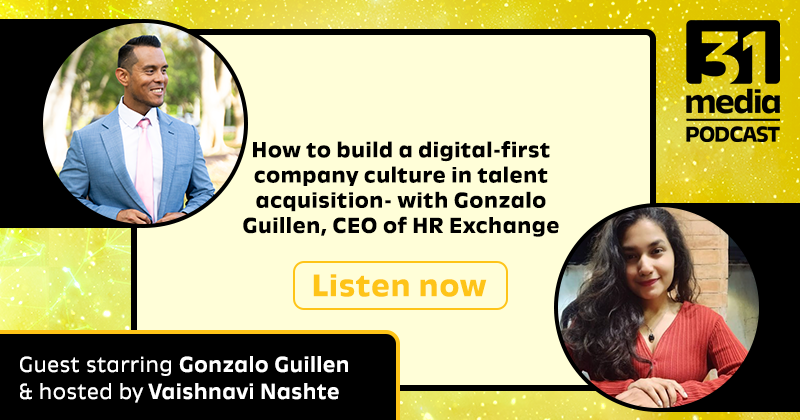This article is published in collaboration with the Digital Transformation and AI Awards and Summit. These are two separate B2B events organised by 31 Media. If you wish to exhibit your tech solutions or to advertise your brand at the event, please get in touch at +44 (0)203 931 5827. In this article, you’ll learn how to build a digital-first company culture in talent acquisition
Author: Gonzalo Guillen, CEO at HR Exchange
Building a Digital-First Company Culture in Talent Acquisition
As the world of work continues to evolve, companies are being challenged to rethink how they approach talent acquisition. The shift toward a digital-first strategy has transformed not only how we recruit but also how we build a company culture that thrives in a modern, tech-driven environment. I’ve had the privilege of working with companies across various industries, and I’ve seen firsthand how a digital-first approach can unlock new opportunities in talent acquisition. Here’s my perspective on what it takes to build a digital-first company culture in this critical area.
The core principles of a digital-first company culture
At the heart of a digital-first culture is the ability to harness technology to improve efficiency and scalability while keeping the human element intact. In talent acquisition, this means using digital tools like applicant tracking systems, AI-powered candidate sourcing, and communication platforms to enhance the recruitment process. But it’s not just about technology for technology’s sake—it’s about how you apply these tools to create a seamless experience for your team and the candidates. It’s essential to design processes that are efficient but also respectful of the candidate’s time and experience.
Keeping the recruitment process personal in a digital world
One of the biggest concerns with digital talent acquisition is the fear of losing the personal touch. We’ve all heard stories of candidates feeling like they’re just a number in the system. The truth is, that automation doesn’t have to be impersonal. With the right tools, you can create more personalised experiences. For example, AI-driven chatbots can handle initial inquiries quickly while tailoring responses based on candidate history. Video interviews and interactive assessments also allow us to get to know candidates better, ensuring that technology enhances – not replaces – the human connection.

How Does Remote Work Enhance Collaboration in Talent Acquisition?
Remote work has changed the game for recruiting teams. Tools like Slack, Zoom, and collaborative platforms allow teams to stay connected and move quickly, regardless of where they’re located. What I’ve found is that remote work, combined with the right digital tools, actually fosters better communication and collaboration. It creates a flexible environment where people can contribute meaningfully without being tied to a physical office. For talent acquisition, this means faster decisions, more diverse perspectives, and a stronger alignment with company culture.
Assessing Soft Skills in a Digital-First Environment
Soft skills are often harder to evaluate, especially when you’re not meeting candidates face-to-face. However, digital tools give us new ways to assess how someone thinks, communicates, and interacts with others. Video interviews are great for this – body language, tone, and communication style come through in ways that a resume can’t capture. Online simulations or real-world scenario tests are also excellent tools for evaluating a candidate’s problem-solving skills and adaptability. With these digital approaches, we can get a fuller picture of a candidate’s potential.
Using Data to Shape a digital-first Talent Acquisition Strategy
In a digital-first strategy, data is your best friend. When used correctly, data analytics can provide critical insights into your recruitment process, helping you identify areas for improvement and make smarter decisions. I’m a strong advocate for using metrics like time-to-hire, quality of hire, and candidate conversion rates to drive decisions. Predictive analytics can also help identify candidates who are more likely to thrive in your company’s environment, saving time and resources while increasing the chances of a successful hire.
Real-World Examples of Successful Digital-First Talent Acquisition
There are plenty of companies that have successfully implemented digital-first recruitment strategies, and I’ve had the pleasure of working with a few of them. Take IBM, for example – they’ve integrated AI throughout their hiring process, reducing the time to screen candidates while improving the quality of hires. They’ve also built a strong digital culture that supports remote work and collaboration. Another great example is Microsoft, where they’ve embraced digital tools to speed up recruitment and create an inclusive culture that prioritises employee well-being.
The key to building a digital-first company culture in talent acquisition is striking the right balance between technology and human connection. When done correctly, it can transform the recruitment process, making it more efficient, data-driven, and candidate-focused. At the end of the day, it’s about leveraging digital tools to enhance – not replace – the relationships that make your company unique.
Get in touch
For event sponsorship enquiries, please get in touch with calum.budge@31media.co.uk
For media enquiries, please get in touch with vaishnavi.nashte@31media.co.uk


